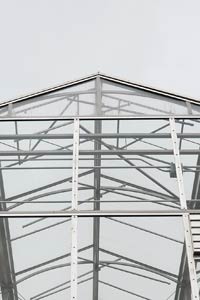5/15/2009
Greenhouse Glazing 101
compiled Jennifer Duffield White

Your greenhouse covering—or glazing—is the one thing that stands between your plants and the dangers of your climate, as well as the essential light needed to produce a perfect crop. Whether you’re just setting out to pick the right glazing for your facility or if you’re looking at replacing or maintaining what you already own—here are some tips from the experts on how to select the right material—be it glass, poly film or a rigid plastic glazing—and how to keep it clean in the years to come.
Selecting a Glazing Material
If you purchase your glazing material from a reputable manufacturer, you can be assured that the fundamental material properties of strength, consistency, durability, manufacturing quality control and safety will be present. With those factors out of the way, your main considerations should be:
- How much energy (light) does the glazing let into the greenhouse, and how much energy (heat) will go out?
- What are the purchase, installation and maintenance costs?
- How well can you manage the environment that’s created by the glazing to produce a quality, saleable product for profit?
The physical properties of the material directly influence the answers to the first two questions. Question No. 2 can be answered by glazing manufacturers or your greenhouse builder. Question No. 3 is generally more difficult to answer. However, it’s related to other factors, such as the experience of the grower, the crop produced, the local outside environment and the environmental control systems you have in the greenhouse.
To begin to answer Question No. 1, consider the following general choices available in glazings:
• Is the glazing made of single- or double-layer construction?
• Is the glazing made of rigid plastic or flexible, thin film?
• Is the glazing material glass or a form of plastic?
• What special-purpose additives, if any, are included?
• How do these choices in glazings influence the plant environment?
Excerpted from the Ball RedBook: Greenhouses and Equipment, Vol. 1, from Chapter 3, written by Gene Giacomelli, director of Controlled Environment Agriculture Program, University of Arizona.
Tricks to Keep Your Glazing Clean
Now that you’ve put up the best-suited structure and covering for your greenhouse, you face the task of maintaining these important places of production. When looking to clean your glazing, you most likely face one of two types of coverings: polyethylene and polycarbonate.
National Greenhouse Manufacturers Association (NGMA) member, Nick Calabro of Klerks Plastic, notes that there are many factors that can influence the process of keeping your glazing clean, from the type of additives you may be using to your location.
Greenhouse polyethylene film isn’t inherently smooth and allows contaminants to adhere to outside surfaces. Manufacturing techniques incorporate anti-dust additives into polyethylene to create smoother surfaces, which reduce the occurrence of dirt accumulation. The addition of anti-dust additives also leads to higher light transmission and a smooth outside layer that facilitates cleaning. Nevertheless, air borne particulates such as road dirt, pesticides, carbon-based fuel emissions, soilless media particles and algae can eventually contribute to film surface dirt buildup. Follow the tips below to prevent dirt buildup.
Polycarbonate sheets are also vulnerable to road dirt, pesticides, carbon-based fuel emissions, soilless media particles and algae. To minimize scratching and clean greenhouse glazing, mild soap or detergent and lukewarm water may be used with a clean sponge or soft cloth. Glazing should always be rinsed well with clean water. Abrasive tools, alkaline cleaners, benzene, gasoline, acetone or carbon tetrachloride should NEVER be used to clean glazing.
Cleaners that are known to be compatible with polycarbonate include: Formula 409 (Clorox Co.); Top Job (Proctor & Gamble); VM & P grade Naphtha Joy (Proctor & Gamble); Windex with Ammonia D (Drackett Products); and Palmolive Liquid (Colgate Palmolive).
Above all, the National Greenhouse Manufacturers Association (NGMA) recommends that you contact your supplier directly and follow their directions regarding cleaning instructions.
Information provided by the NGMA. To learn more about the members of NGMA and to find a local supplier near you, visit www.ngma.com.
3 Ways to Reduce Dirt Buildup
Here are a few ways you can reduce and eliminate greenhouse film dirt buildup on polyethylene.
1. Use an outside air source for double-layer air inflation installations.
Inflation units having an outside air source draw cooler and lower-moisture air that normally has lower levels of airborne contaminants and pesticides. Outside air intake units used in combination with mesh filters can reduce the intake of outside road dirt and insects. Road paving, grass buffer zones and wind breaks also can reduce airborne contaminates from entering the outside air flow.
2. Clear greenhouse film surfaces.
You can physically clean exposed outside and inside film surfaces with non-reactive cleaning mixtures and non-abrasive soft brushes. Quaternary ammonium chloride salts (Green-Shield, Physan 20 and Triathlon) are commonly used by growers and are quite stable. They work well when used according to label instructions. Sodium carbonate peroxyhydrate (GreenClean Granular Algaecide, TerraCyte) algaecides are granular and activated with water.
3. Avoid pesticide contact.
Pesticides containing sulfur and chlorine have a negative influence on the lifetime of a film. Avoided direct pesticide contact with greenhouse film surfaces, keeping in mind that many pesticides will accelerate aging of the film when used in high concentrations.
Information provided by the National Greenhouse Manufacturers Association.